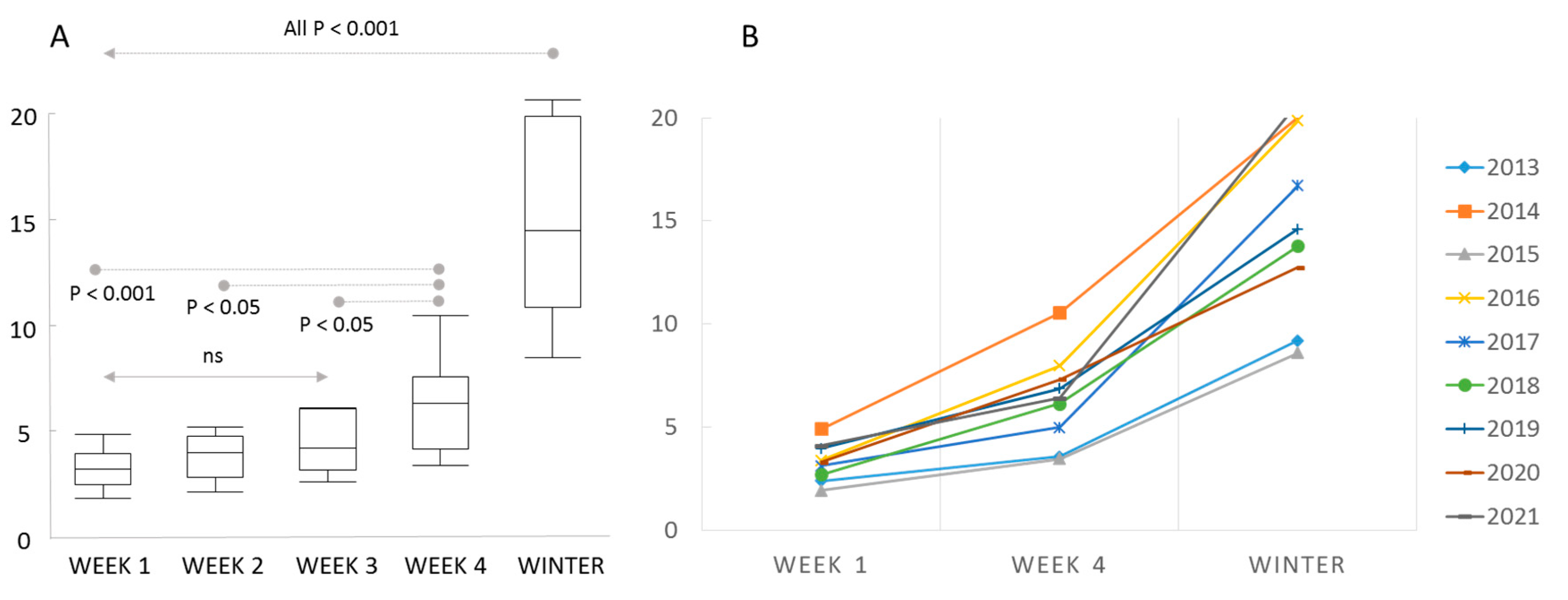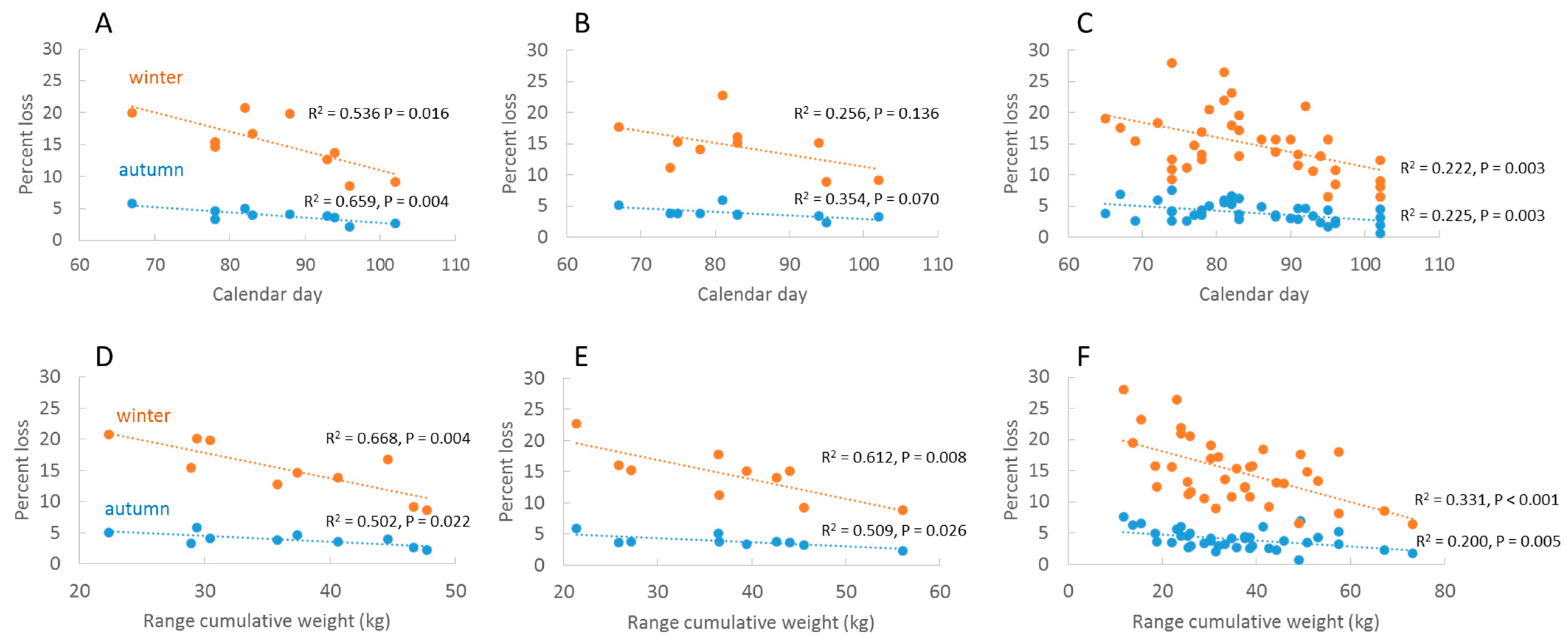Annual Fluctuations in Winter Colony Losses of Apis mellifera L. Are Predicted by Honey Flow Dynamics of the Preceding Year
Abstract
Simple Summary
Abstract
1. Introduction
2. Methods
2.1. Surveys
2.2. Automated Hive Scale Network “TrachtNet” and Variables
2.3. Temperature Estimation
2.4. Correlations with Varroa Destructor Abundance
2.5. Statistics
3. Results
3.1. Loss Rates in Autumn and Winter
3.2. Honey Flow Variables and Loss Rates
3.3. Honey Flow and Temperature
3.4. Honey Flow Variables and Varroa Destructor
4. Discussion
5. Conclusions
Supplementary Materials
Author Contributions
Funding
Institutional Review Board Statement
Informed Consent Statement
Data Availability Statement
Acknowledgments
Conflicts of Interest
References
- Paudel, Y.P.; Mackereth, R.; Hanley, R.; Qin, W. Honey bees (Apis mellifera L.) and pollination issues: Current status, impacts and potential drivers of decline. J. Agric. Sci. 2015, 7, 93. [Google Scholar] [CrossRef]
- Khalifa, S.A.M.; Elshafiey, E.H.; Shetaia, A.A.; El-Wahed, A.A.A.; Algethami, A.F.; Musharraf, S.G.; AlAjmi, M.F.; Zhao, C.; Masry, S.H.D.; Abdel-Daim, M.M.; et al. Overview of bee pollination and its economic value for crop production. Insects 2021, 12, 688. [Google Scholar] [CrossRef]
- EU Commission. Honey Market Overview (Spring 2022). 2022. Available online: https://agriculture.ec.europa.eu/farming/animal-products/honey_en (accessed on 8 September 2022).
- USDA-National Agricultural Statistics Service Information. Honey: Release 18.03.2022. Available online: https://usda.library.cornell.edu/concern/publications/hd76s004z?locale=en (accessed on 8 September 2022).
- van der Zee, R.; Gray, A.; Holzmann, C.; Pisa, L.; Brodschneider, R.; Chlebo, R.; Coffey, M.F.; Kence, A.; Kristiansen, P.; Mutinelli, F.; et al. Standard survey methods for estimating colony losses and explanatory risk factors in Apis mellifera. J. Apic. Res. 2013, 52, 1–36. [Google Scholar] [CrossRef]
- Brodschneider, R.; Gray, A.; van der Zee, R.; Adjlane, N.; Brusbardis, V.; Charrière, J.-D.; Chlebo, R.; Coffey, M.F.; Crailsheim, K.; Dahle, B.; et al. Preliminary analysis of loss rates of honey bee colonies during winter 2015/16 from the COLOSS survey. J. Apic. Res. 2016, 55, 375–378. [Google Scholar] [CrossRef]
- Gray, A.; Brodschneider, R.; Adjlane, N.; Ballis, A.; Brusbardis, V.; Charrière, J.-D.; Chlebo, R.; Coffey, M.F.; Cornelissen, B.; da Costa, C.A.; et al. Loss rates of honey bee colonies during winter 2017/18 in 36 countries participating in the COLOSS survey, including effects of forage sources. J. Apic. Res. 2019, 58, 479–485. [Google Scholar] [CrossRef]
- Gray, A.; Adjlane, N.; Arab, A.; Ballis, A.; Brusbardis, V.; Charrière, J.-D.; Chlebo, R.; Coffey, M.F.; Cornelissen, B.; da Costa, C.A.; et al. Honey bee colony winter loss rates for 35 countries participating in the COLOSS survey for winter 2018–2019, and the effects of a new queen on the risk of colony winter loss. J. Apic. Res. 2020, 59, 744–751. [Google Scholar] [CrossRef]
- Steinhauer, N.A.; Rennich, K.; Wilson, M.E.; Caron, D.M.; Lengerich, E.J.; Pettis, J.S.; Rose, R.; Skinner, J.A.; Tarpy, D.R.; Wilkes, J.T.; et al. A national survey of managed honey bee 2012–2013 annual colony losses in the USA: Results from the Bee Informed Partnership. J. Apic. Res. 2014, 53, 1–18. [Google Scholar] [CrossRef]
- Kulhanek, K.; Steinhauer, N.; Rennich, K.; Caron, D.M.; Sagili, R.R.; Pettis, J.S.; Ellis, J.D.; Wilson, M.E.; Wilkes, J.T.; Tarpy, D.R.; et al. A national survey of managed honey bee 2015–2016 annual colony losses in the USA. J. Apic. Res. 2017, 56, 328–340. [Google Scholar] [CrossRef]
- Tang, J.; Ma, C.; Shi, W.; Chen, X.; Liu, Z.; Wang, H.; Chen, C. A National survey of managed honey bee colony winter losses (Apis mellifera) in China (2013–2017). Diversity 2020, 12, 318. [Google Scholar] [CrossRef]
- Jacques, A.; Laurent, M.; EPILOBEE Consortium; Ribière-Chabert, M.; Saussac, M.; Bougeard, S.; Budge, G.E.; Hendrikx, P.; Chauzat, M.-P. A pan-European epidemiological study reveals honey bee colony survival depends on beekeeper education and disease control. PLoS ONE 2017, 12, e0172591. [Google Scholar] [CrossRef]
- DIB—German Beekeepers Association. Available online: https://deutscherimkerbund.de/160-Die_deutsche_Imkerei_auf_einen_Blick (accessed on 21 July 2022). (in German).
- Brodschneider, R.; Schlagbauer, J.; Arakelyan, I.; Balli, A.; Brus, J.; Brusbardis, V.; Cadahia, L.; Charrière, J.-D.; Chlebo, R.; Coffey, M.F.; et al. Spatial clusters of Varroa destructor control strategies in Europe. J. Pest Sci. 2022. [Google Scholar] [CrossRef]
- Debimo Consortium 2021. Zwischenbericht 2020. Available online: https://bienenmonitoring.uni-hohenheim.de/ (accessed on 1 August 2022). (in German).
- Seeley, T.D.; Visscher, P.K. Survival of honeybees in cold climates: The critical timing of colony growth and reproduction. Ecol. Entomol. 1985, 10, 81–88. [Google Scholar] [CrossRef]
- Abou-Shaara, H.F.; Owayss, A.A.; Ibrahim, Y.Y.; Basuny, N.K. A review of impacts of temperature and relative humidity on various activities of honey bees. Insectes Sociaux 2017, 64, 455–463. [Google Scholar] [CrossRef]
- Li, X.; Ma, W.; Shen, J.; Long, D.; Feng, Y.; Su, W.; Xu, K.; Jiang, Y. Tolerance and response of two honeybee species Apis cerana and Apis mellifera to high temperature and relative humidity. PLoS ONE 2019, 14, e0217921. [Google Scholar] [CrossRef]
- Nürnberger, F.; Härtel, S.; Steffan-Dewenter, I. The influence of temperature and photoperiod on the timing of brood onset in hibernating honey bee colonies. PeerJ 2018, 6, e4801. [Google Scholar] [CrossRef]
- Switanek, M.; Crailsheim, K.; Truhetz, H.; Brodschneider, R. Modelling seasonal effects of temperature and precipitation on honey bee winter mortality in a temperate climate. Sci. Total Environ. 2017, 579, 1581–1587. [Google Scholar] [CrossRef]
- Awad, A.M.; Owayss, A.A.; Alqarni, A.S. Performance of two honey bee subspecies during harsh weather and Acacia gerrardii nectar-rich flow. Sci. Agric. 2017, 74, 474–480. [Google Scholar] [CrossRef][Green Version]
- Calovi, M.; Grozinger, C.M.; Miller, D.A.; Goslee, S.C. Summer weather conditions influence winter survival of honey bees (Apis mellifera) in the northeastern United States. Sci. Rep. 2021, 11, 1553. [Google Scholar] [CrossRef]
- Smoliński, S.; Langowska, A.; Glazaczow, A. Raised seasonal temperatures reinforce autumn Varroa destructor infestation in honey bee colonies. Sci. Rep. 2021, 11, 22256. [Google Scholar] [CrossRef]
- Genersch, E.; von der Ohe, W.; Kaatz, H.; Schroeder, A.; Otten, C.; Büchler, R.; Berg, S.; Ritter, W.; Mühlen, W.; Gisder, S.; et al. The German bee monitoring project: A long term study to understand periodically high winter losses of honey bee colonies. Apidologie 2010, 41, 332–352. [Google Scholar] [CrossRef]
- Natsopoulou, M.E.; McMahon, D.P.; Doublet, V.; Frey, E.; Rosenkranz, P.; Paxton, R.J. The virulent, emerging genotype B of Deformed wing virus is closely linked to overwinter honeybee worker loss. Sci. Rep. 2017, 7, 5242. [Google Scholar] [CrossRef] [PubMed]
- Hristov, P.; Shumkova, R.; Palova, N.; Neov, B. Factors associated with honey bee colony losses: A mini-review. Vet. Sci. 2020, 7, 166. [Google Scholar] [CrossRef] [PubMed]
- Steinhauer, N.; Aurell, D.; Bruckner, S.; Wilson, M.; Rennich, K.; vanEngelsdorp, D.; Williams, G. United States Honey Bee Colony Losses 2020–2021: Preliminary Results. Available online: https://beeinformed.org/2021/06/21/united-states-honey-bee-colony-losses-2020-2021-preliminary-results/ (accessed on 27 July 2022).
- Otten, C.; Berg, S. TrachtNet 5.0—Die Bundesweite elektronische Trachtbeobachtung ist für jeden nutzbar. Bienen Nat. 2018, 18–19. [Google Scholar]
- JMP® 13.2.1; SAS Institute Inc.: Cary, NC, USA, 2016.
- Garsd, A.; Howard, W.E. A 19-year study of microtine population fluctuations using time-series analysis. Ecology 1981, 62, 930–937. [Google Scholar] [CrossRef]
- Roy, D.B.; Rothery, P.; Moss, D.; Pollard, E.; Thomas, J.A. Butterfly numbers and weather: Predicting historical trends in abundance and the future effects of climate change. J. Anim. Ecol. 2001, 70, 201–217. [Google Scholar]
- Beyer, M.; Junk, J.; Eickermann, M.; Clermont, A.; Kraus, F.; Georges, C.; Reichart, A.; Hoffmann, L. Winter honey bee colony losses, Varroa destructor control strategies, and the role of weather conditions: Results from a survey among beekeepers. Res. Vet. Sci. 2018, 118, 52–60. [Google Scholar] [CrossRef]
- Morawetz, L.; Köglberger, H.; Griesbacher, A.; Derakhshifar, I.; Crailsheim, K.; Brodschneider, R.; Mossbeckhofer, R. Health status of honey bee colonies (Apis mellifera) and disease-related risk factors for colony losses in Austria. PLoS ONE 2019, 14, e0219293. [Google Scholar]
- Taha, E.-K.A.; Al-Kahtani, S.N. Comparison of the activity and productivity of Carniolan (Apis mellifera carnica Pollmann) and Yemeni (Apis mellifera jemenitica Ruttner) subspecies under environmental conditions of the Al-Ahsa oasis of eastern Saudi Arabia. Saudi J. Biol. Sci. 2019, 26, 681–687. [Google Scholar] [CrossRef]
- Burrill, R.M.; Dietz, A. The response of honey bees to variations in solar radiation and temperature. Apidologie 1981, 12, 319–328. [Google Scholar] [CrossRef]
- Vicens, N.; Bosch, J. Weather-dependent pollinator activity in an apple orchard, with special reference to Osmia cornuta and Apis mellifera (Hymenoptera: Megachilidae and Apidae). Environ. Entomol. 2000, 29, 413–420. [Google Scholar] [CrossRef]
- Scaven, V.L.; Rafferty, N.E. Physiological effects of climate warming on flowering plants and insect pollinators and potential consequences for their interactions. Curr. Zool. 2013, 59, 418–426. [Google Scholar] [CrossRef] [PubMed]
- Nürnberger, F.; Härtel, S.; Steffan-Dewenter, I. Seasonal timing in honey bee colonies: Phenology shifts affect honey stores and varroa infestation levels. Oecologia 2019, 189, 1121–1131. [Google Scholar] [CrossRef] [PubMed]
- Rinderer, T.E.; Rothenbuhler, W.C.; Gochnauer, T.A. The influence of pollen on the susceptibility of honey-bee larvae to Bacillus larvae. J. Invertebr. Pathol. 1974, 23, 347–350. [Google Scholar] [CrossRef]
- DeGrandi-Hoffman, G.; Chen, Y.; Huang, E.; Huang, M.H. The effect of diet on protein concentration, hypopharyngeal gland development and virus load in worker honey bees (Apis mellifera L.). J. Insect Physiol. 2010, 56, 1184–1191. [Google Scholar] [CrossRef]






| Autumn Loss | Winter Loss | ||||||
|---|---|---|---|---|---|---|---|
| Variable | Variable Abbr. | Germany (N = 10) | RP (N = 10) | Regions (N = 38) | Germany (N = 10) | RP (N = 10) | Regions (N = 38) |
| Calendar day, first minimum | fMinCal | –0.812 ** | –0.595 + | –0.471 ** | –0.732 * | –0.506 ns | –0.475 ** |
| Calendar day, absolute minimum | aMinCal | –0.535 ns | –0.602 + | –0.246 ns | –0.260 ns | -0.464 ns | –0.298 + |
| Honey flow period | HF-Period | 0.562 ns | 0.378 ns | 0.208 ns | 0.501 ns | 0.014 ns | 0.080 ns |
| Honey flow range | RangeCW | –0.709 * | –0.713 * | –0.447 ** | –0.817 ** | –0.783 ** | –0.576 *** |
| GDD on calendar day | GDD-Day | - | –0.129 ns | –0.207 ns | - | –0.186 ns | –0191 ns |
Publisher’s Note: MDPI stays neutral with regard to jurisdictional claims in published maps and institutional affiliations. |
© 2022 by the authors. Licensee MDPI, Basel, Switzerland. This article is an open access article distributed under the terms and conditions of the Creative Commons Attribution (CC BY) license (https://creativecommons.org/licenses/by/4.0/).
Share and Cite
Johannesen, J.; Wöhl, S.; Berg, S.; Otten, C. Annual Fluctuations in Winter Colony Losses of Apis mellifera L. Are Predicted by Honey Flow Dynamics of the Preceding Year. Insects 2022, 13, 829. https://doi.org/10.3390/insects13090829
Johannesen J, Wöhl S, Berg S, Otten C. Annual Fluctuations in Winter Colony Losses of Apis mellifera L. Are Predicted by Honey Flow Dynamics of the Preceding Year. Insects. 2022; 13(9):829. https://doi.org/10.3390/insects13090829
Chicago/Turabian StyleJohannesen, Jes, Saskia Wöhl, Stefen Berg, and Christoph Otten. 2022. "Annual Fluctuations in Winter Colony Losses of Apis mellifera L. Are Predicted by Honey Flow Dynamics of the Preceding Year" Insects 13, no. 9: 829. https://doi.org/10.3390/insects13090829
APA StyleJohannesen, J., Wöhl, S., Berg, S., & Otten, C. (2022). Annual Fluctuations in Winter Colony Losses of Apis mellifera L. Are Predicted by Honey Flow Dynamics of the Preceding Year. Insects, 13(9), 829. https://doi.org/10.3390/insects13090829





